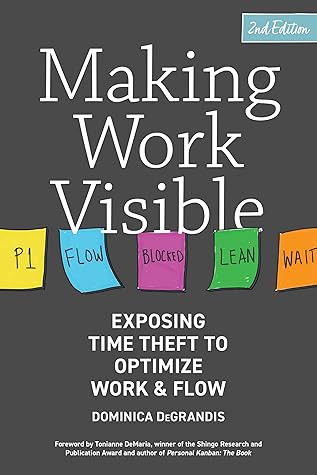More on this book
Community
Kindle Notes & Highlights
Read between
March 20 - May 13, 2023
There are many ways to prioritize. Assigned priority, CoD, FIFO, HiPPO, and WSJF are some of these options.
To make neglected work obvious, flag work items that haven’t moved or been updated within a certain number of days.
If expectations are set correctly, not everything needs a due date. Being predictable is what counts. Being predictable saves time.
Becoming more predictable means we need to talk about probability and how, once we are able to shift to a more probabilistic approach, expectations around timeframes can be improved. It’s all about the expectations. Setting better expectations makes leadership happy and helps make those uncomfortable stand-ups and retrospectives surprisingly fun.
A lack of data often leads to people making decisions based on opinions, which are likely to be more problematic than decisions based on good data (i.e., visible work).
Some of the best metrics that show actual progress (or lack thereof) are lead time, cycle time, WIP, and aging reports.
Flow time is a measure of how long something took to do from beginning to end.
Collecting historical flow times that show, for example, that 90% of a certain type of work gets delivered within ten days allows us to say that nine out of ten times we deliver these kinds of requests within ten days.
Actionable Agile Metrics for Predictability: An Introduction.
the bigger the queue, the longer things take.
Queueing theory is a field of applied statistics that studies waiting lines. It allows us to quantify relationships between wait times and capacity utilization, even when arrivals and service times are highly variable. If requests arrive faster than the system can service them, they queue up.
When it comes to efficiency, time is wasted when there is too much focus on resource efficiency overflow.
In knowledge work, however, problems with coordination costs grow nonlinearly with batch size. Old school management assumptions about economies of scale do not apply to knowledge work problems, such as software development.
One of the best predictors of short lead times is small batch sizes of work.
when the company has a culture that is focused on keeping people busy (instead of on keeping work flowing), it invariably results in overloading people with too much WIP. This is not a productive culture. We want to avoid the mistake of having a goal to keep people busy all the time when the goal should be to generate value for the business.
When the focus is on the metric instead of the goal, it’s a problem.
Like a false promise, Gantt charts (jokingly called “can’t charts” by some) fool us into believing that timeline accuracy based on estimates is doable.
Instead of giving due dates, reduce WIP, prioritize by CoD, and reduce batch size. Instead of organizing by projects, organize by product and decouple dependencies on architecture or single threaded skill sets that increase wait times and lengthen queues.
four elements he believes are necessary for a visualization to work:1 •Information: The data must have integrity and must be accurate. •Function: The goal must be useful and efficient. •Visual form: The metaphor must have beauty and structure. •Story: The concept must be interesting and relevant.
Overconfidence Bias: a pervasive optimistic view of our own abilities causing people to take greater risks.
It seems that planners and decision makers with power and confidence, those who frequently rely on gut feelings, might want to consider comparing their decisions with data-driven experimentation. The gut can be overly optimistic. So, while confidence is a fruitful characteristic, the profits are available only to, as Khaneman says, “individuals who are mildly biased and who are able to accentuate the positive without losing track of reality.”
Confirmation Bias: the tendency to search for, interpret, favor, and recall information in a way that confirms or supports one’s beliefs or values. Using information that fits in with existing beliefs while ignoring information that doesn’t fit in with those beliefs. People seek data that is likely to be compatible with the beliefs they currently hold.
Dunning-Kruger Effect: the tendency for unskilled individuals to overestimate their own ability, and the tendency for experts to underestimate their own ability.


